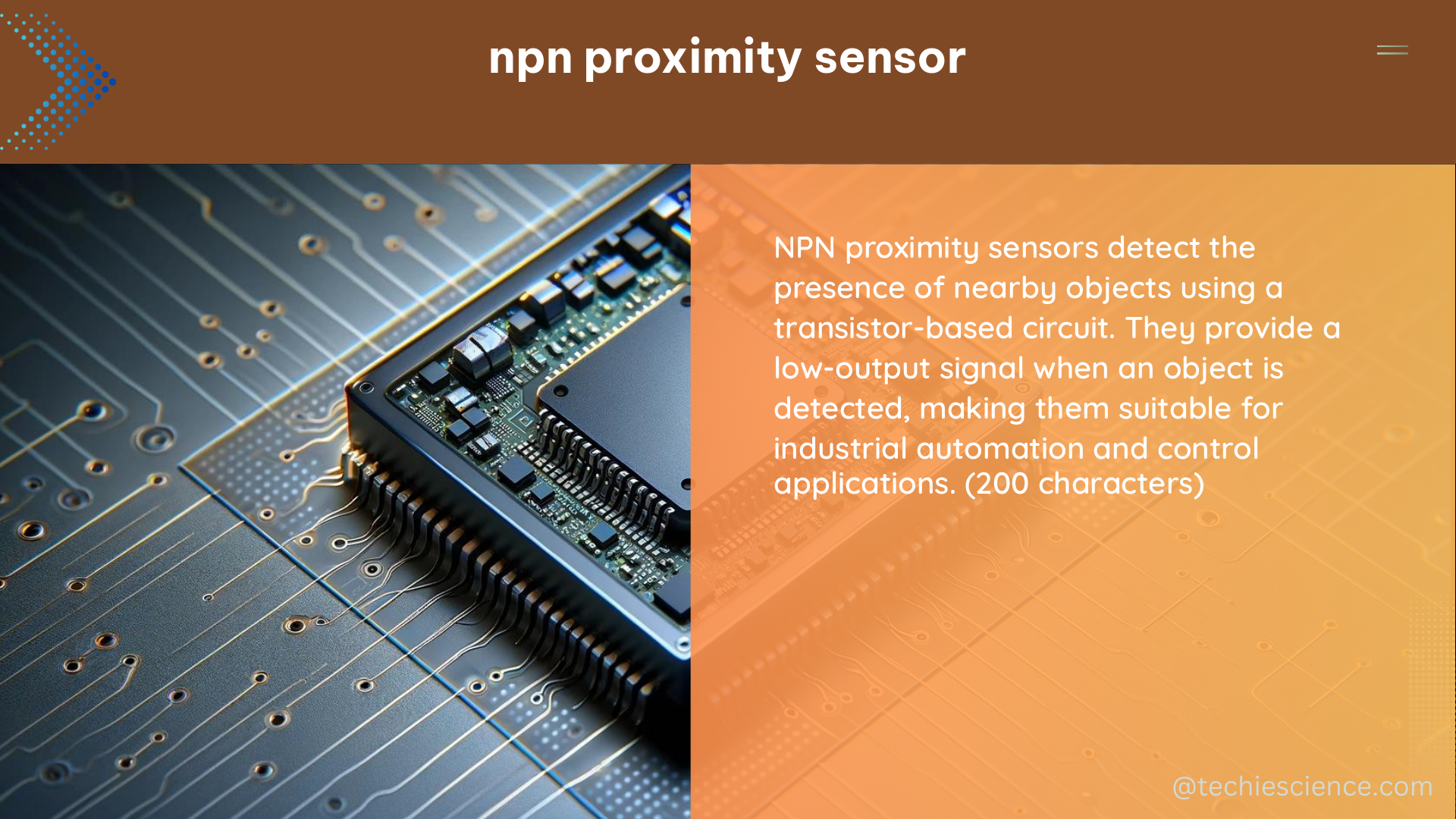NPN proximity sensors are a type of inductive sensor that detect the presence of metal objects without any physical contact. They are widely used in industrial automation, robotics, and manufacturing for position sensing, object detection, and level measurement. This guide delves into the technical specifications of NPN proximity sensors, provides hands-on details, and discusses a DIY project.
Technical Specifications
- Output Type: NPN proximity sensors have an NPN open collector output, which means they provide a low-side switch to ground. This output type is compatible with most PLCs and microcontrollers.
- Supply Voltage: The supply voltage for NPN proximity sensors typically ranges from 10 to 30 VDC, with a standard operating voltage of 24 VDC.
- Operating Principle: NPN proximity sensors work on the principle of electromagnetic induction. When a metal object enters the sensing range, it induces a current in the sensor’s coil, which in turn switches the NPN transistor on or off.
- Sensing Range: The sensing range varies depending on the sensor’s model and size. For example, the Contrinex NPN NO Embeddable DW-AD-501-P8 sensor has a sensing range of up to 5 mm, while the Pepperl+Fuchs NPN NO Cylindrical Sensor NBB2-V3-E2-V1 has a sensing range of up to 2 mm.
- Switching Frequency: The switching frequency of NPN proximity sensors can reach up to 10 kHz, making them suitable for high-speed applications. The typical switching frequency for most NPN proximity sensors is in the range of 1 to 5 kHz.
- Cycle Time: The cycle time of NPN proximity sensors is typically in the order of 10 µs, with a response time of less than 1 ms.
- Temperature Range: NPN proximity sensors can operate in a wide temperature range, typically from -25°C to +70°C, with some models rated for extended temperature ranges of -40°C to +85°C.
- Protection Class: NPN proximity sensors are available in different protection classes, such as IP67 and IP69K, to ensure durability and reliability in harsh environments. The IP67 rating indicates that the sensor is dust-tight and can withstand temporary immersion in water, while the IP69K rating ensures protection against high-pressure, high-temperature water jets.
Hands-on Details

When working with NPN proximity sensors, it is essential to consider the following aspects:
- Connection Diagram: NPN proximity sensors require a specific connection diagram, which includes connecting the supply voltage, ground, and output to the PLC or microcontroller. It is crucial to ensure that the output is connected to an input with a pull-up resistor.
- Pull-up Resistor: An external pull-up resistor or an internal pull-up resistor in the PLC or microcontroller is necessary to ensure proper operation of the NPN proximity sensor. The value of the resistor typically ranges from 1 kΩ to 10 kΩ, with a common value of 4.7 kΩ.
- Ground Connection: It is essential to connect the ground of the NPN proximity sensor to the ground of the PLC or microcontroller to ensure proper operation and prevent potential ground loops.
- Power Supply: The power supply for the NPN proximity sensor should meet the sensor’s specifications in terms of voltage and current. A voltage limiting circuit, such as a set of diodes or a z-diode, can be used to protect the sensor from overvoltage and ensure reliable operation.
DIY Project
To demonstrate the operation of an NPN proximity sensor, we can build a simple DIY project using an Arduino Uno and an NPN proximity sensor. The project involves connecting the sensor to the Arduino Uno and programming it to detect the presence of metal objects. The following steps outline the project:
- Connect the NPN proximity sensor to the Arduino Uno: Connect the sensor’s supply voltage (typically 24 VDC) to the Vin pin of the Arduino Uno, the ground to a common ground, and the output to digital pin 2 of the Arduino Uno.
- Configure the Arduino Uno input: Set digital pin 2 of the Arduino Uno as an input with an internal pull-up resistor of 20 kΩ.
- Read the sensor value: Use the Arduino Uno to read the value of digital pin 2 and determine whether a metal object is present or not. The sensor output will be low (0V) when a metal object is detected, and high (5V) when no object is present.
- Program the Arduino Uno: Write a program in Arduino IDE to read the sensor value, detect the presence of metal objects, and display the results on the serial monitor. You can also use the sensor output to control other devices, such as LEDs or relays, based on the detected object.
By following this DIY project, you can gain hands-on experience with NPN proximity sensors and learn how to integrate them into your own projects.
References:
- Festo: Inductive Proximity Switches – https://www.festo.com/gb/en/c/products/industrial-automation/sensors/inductive-proximity-switches-id_pim129/
- Electronics Stack Exchange: How to tell if a proximity sensor is NPN or PNP – https://electronics.stackexchange.com/questions/543020/how-to-tell-if-a-proximity-sensor-is-npn-or-pnp
- NI Community: NPN proximity sensor connection – https://forums.ni.com/t5/Multifunction-DAQ/NPN-proximity-sensor-connection/td-p/4142897
- Arduino Forum: Using a NPN Proximity sensor with an arduino uno – https://forum.arduino.cc/t/using-a-npn-proximity-sensor-with-an-arduino-uno/540345
- YouTube: Collecting digital data from PNP and NPN proximity sensors with Arduino – https://www.youtube.com/watch?v=bfcgFxwOjHI

The lambdageeks.com Core SME Team is a group of experienced subject matter experts from diverse scientific and technical fields including Physics, Chemistry, Technology,Electronics & Electrical Engineering, Automotive, Mechanical Engineering. Our team collaborates to create high-quality, well-researched articles on a wide range of science and technology topics for the lambdageeks.com website.
All Our Senior SME are having more than 7 Years of experience in the respective fields . They are either Working Industry Professionals or assocaited With different Universities. Refer Our Authors Page to get to know About our Core SMEs.